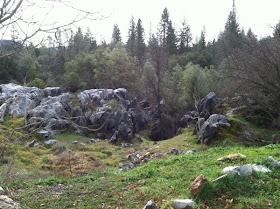Tuesday, February 21, 2012
Columbia, California, trip
Youngsters in California learn two things about the state's history-- the Gold Rush and the Spanish Missions. I had a lesson in the former last weekend, when I visited the town of Columbia, in the Sierra Nevada foothills.
The reason we went up there was for my friend and old neighbor John's wedding. He and I were supposed to be exercise buddies. We were supposed to encourage each other early every morning and walk around a nearby lake. That didn't quite work out. By the third week, we stopped walking in the mornings. Instead, we ended up drinking beer and BBQ'ing after work almost every evening.
The ceremony was held in a converted barn. It was the coolest wedding venue I've ever been to.
We stayed at a B&B atop a hill. It was right next to the old school house, seen below.
The town was surrounded by these strange looking rocks. There's supposedly a marble quarry nearby.
During the Gold Rush, about $150 million worth of gold was mined out of the town and its environs. At one point, it was the second largest settlement in California. The town is closed off to motorized vehicle traffic. The historic buildings are all in use. Schoolchildren are often bussed here to witness what life was like in the 1850s.
The Masons and Odd Fellows had a strong presence in the region.
When was the last time you saw a Bronco II?
This is St. Anne's Church, the oldest brick church in California. There are not many made of bricks because of earthquakes.
There was a sign that told the story of three Chilean women who moved up here during the Gold Rush. Somehow, against all odds in a male-dominated world, they bought up a lot of property in town and became successful landlords.
The building below is the only remaining building in the Chinese section of town. That section used to be the French Quarter, but the Chinese pushed the Frenchmen out. A fire that started in the Chinese section burned down all of Columbia. When the town was re-built, the Chinese were not allowed to live within town limits.












Was there any Chilean relic to be seen? Chilean colonization (of sorts) of California is something I don't know enough about and that isn't very well known here... the only I've read is really a book by Isabel Allende claiming El Zorro was Chilean.
ReplyDeleteRegardless of the Chilean connection, Columbia looks like a must-see. I loved the church and the idea of using an old barn for weddings. And as you said, the fact it has survived earthquakes well is another reason to go there (quickly).
Beds with springs as something special! Kodak film! Certainly things of the past.
@Viva: Here is a piece about Chileans in the California Gold Rush. This probably explains why traditional bars in San Francisco serve pisco sours.
ReplyDeletehttp://www.pbs.org/wgbh/amex/goldrush/peopleevents/p_rosales.html
Two years later, but I figured I might as well make a comment. We used to camp at the Marble Quarry RV Resort every summer when I was little. My father had a bunch of friends that lived (and gold mined) in Columbia. The rocks that you saw around town are from the old mining days. The miners used a technique where they used high pressure water hoses to blast the dirt away from the rock. The dirt was then run through sluice boxes or panned to remove the gold. The old marble quarry is still there. We used to play in it, despite the mountain lions and rattlesnakes. Another fun fact, many movies have been filmed in and around Columbia. The movie "Radio Flyer" was filmed at the Columbia Airport, and Back to the Future III was filmed in nearby Jamestown. I have fond memories of my time spent in Columbia. Thanks for the mentioning the rocks since that is what I was searching for!
ReplyDelete